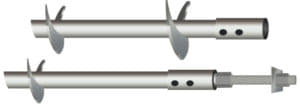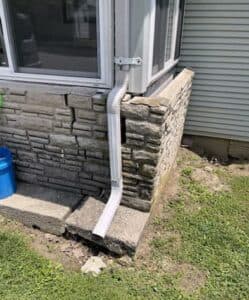
There are definitely situations where bigger is better. If you’re hosting a kid’s birthday party, a sheet cake is far superior to a lone cupcake. But there are other times- like when you’re trying to fix something- that having the correctly-sized socket wrench is much more helpful than having a large hammer.
Acculevel is a family-owned and operated contractor that specializes in repairing foundations and waterproofing homes. We are experts at providing whole-home solutions for homeowners, whether they need repairs for sagging floors, uneven concrete, hydrostatic pressure, or settling foundations. Since our start in 1996, we’ve helped more than 35,000 homeowners return their homes to full strength and health.
If your house foundation is settling, you need to install piers to secure and stabilize it. Everyone in our industry agrees that piers are the best repair method.
But we don’t all agree on the type or size of the pier. Some companies use piers that may not be the best fit for your home and situation.
We’re going to explain why pier size is not the most important aspect of a repair. Installing the right pier- and in the right locations- is much more critical.
There are two types of piers that are used to stabilize (and sometimes lift) a settling foundation: push piers and helical piers. Both of these are long steel tubes that are driven into the soil next to your home’s foundation. The biggest difference between them is the installation process.
Push piers are- as the name suggests- pushed into the earth next to your foundation. They are attached to your home’s footing and then forced into the soil. They work by letting the weight of your home push them down, leveraging the weight of the home to create lift.
At Acculevel, we don’t like to use push piers for residential purposes. A ranch style home often doesn’t weigh enough for push piers to be effective. If the pier doesn’t reach the needed depth to secure the pier, it won’t stabilize the foundation. Trying to force this to happen can actually strain your foundation.

This is an illustration of a helical pier.
Helical piers are also hollow posts, but they have “blades” that stick out from the sides. This allows them to be screwed into the earth; when they reach undisturbed ground, they anchor themselves into place. It’s only at this point that the piers are attached to the home’s foundation footing.
Both piers should be installed to the needed depth, measured by pressure gauge. The depth needed can vary, depending on soil type, soil density, and the type of equipment used. (The gauges for machine-dug and hand-dug are different.)
Even when helical piers and push piers come in the same diameter options, that doesn’t automatically mean they are equal in capacity. When you compare the two piers, size is not the first factor to consider. You need to know how the pier was manufactured.
Piers can be constructed in two different ways. They can be made of a flat piece of steel that is shaped into a round pipe, then welded to hold the shape.
Other piers, like the ones Acculevel uses, are “punched” out of a large block of steel. There’s no assembly required, because they’re round from the beginning. We don’t want to use piers with welded seams; a weld is a weak spot that can break if they’re under too much pressure.
We just established that welded piers are not as strong as solid ones, but there are other benefits.
In a nutshell, a solid steel pier costs less while being better for your home and easier to install.
Most foundation repair companies only keep a few different size piers in stock. Acculevel stocks 3 sizes, which are enough to cover both residential and commercial uses.
This is the smallest pier we use. It’s usually substantial enough to stabilize a single story home, regardless of basement or crawl space.
 |
 |
We used 2 ⅜ piers to lift and stabilize this settling porch. The picture on the left was taken by an Acculevel project advisor during a free in-home assessment. The photo on the right was taken by an Acculevel crew member during pier installation (the pier bracket is visible in the bottom right corner).
If your home is two or three stories tall, we prefer to use this mid-range size pier. If your goal is lifting your home towards its original position, this is also the size we recommend. However, foundation lift is never guaranteed. Never.
[box type="warning"] Installing piers requires practice and experience; if you force a home to move beyond its resistance point, you will cause massive damage to the home’s structure. [/box]
Steel piers that are more than 3 inches wide are only necessary for very large structures. These would be multi-story buildings like hotels, apartment complexes, or grain bins (yes, these can settle, too!).
We only provide a brief overview of the installation methods in this article. If you’d like to learn more, please check out this comparison between using helical and push piers.
If you’re interested in a more technical analysis? We compare specifications directly from pier manufacturers in another blog.
And if you’re here looking for information about costs of pier installation, we have you covered!
You will need an experienced and qualified foundation repair contractor, if you need piers installed. Obviously, you always want someone who knows what they’re doing! But this is absolutely essential for this particular repair method.
Piers in the wrong location don’t address your home’s settling problem. Piers installed in the correct location, but not to a necessary depth? Also not solving the problem. And piers that are installed incorrectly can cause additional damage to an already struggling foundation.
If you’re unsure about how to find the best and most qualified contractor for you, please use our guide to questions to ask a contractor. This thorough questionnaire was a collaborative effort from the entire Acculevel staff (customer service, technicians, sales, crew, management). We wanted to provide a guide that covers all of the FAQs we receive from homeowners, and allows you to feel confident in your decision.
Of course, if you live in our service area (Indiana and the surrounding area), you can contact Acculevel. We would be happy to schedule an in-home appointment for you with one of our foundation experts.
Your project advisor will discuss your concerns, evaluate the entire home for possible issues, then review their findings and recommended options. As a team, you’ll decide on the best whole-home solution for you and your family.
[DISPLAY_ULTIMATE_SOCIAL_ICONS]